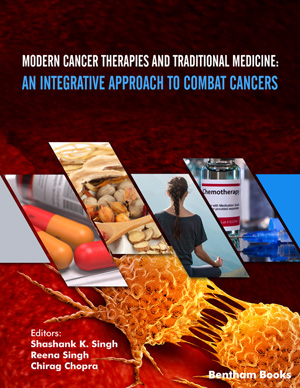Abstract
Green nanotechnology can offer notable advantages over the conventional drug delivery methods in terms of improved drug stability, drug-carrying capacity, site-specificity, and feasibility to apply different routes of administration with less systemic toxicities. Metal nanoparticles bio fabricated with phytoconstituents and microbial extracts have gained significant interest for the treatment of various solid tumors including hepatocellular carcinoma. Hepatocellular carcinoma (HCC) is an aggressive cancer with a very poor prognosis. The current treatments of HCC fails to provide tumor specificity, causing many systemic toxicities and poor overall survival benefits especially for patients in advanced and terminal stages. A novel therapeutic approach with maximal therapeutic effect and minimum adverse effects are urgently required for HCC patients. Green synthesized metal nanoparticles offer significant anticancer effects along with minimal systemic toxicities because of their site-specific delivery into the tumor microenvironment (TME). Green synthesized metal nanoparticles can therefore be a highly beneficial strategy for the treatment of HCC if properly validated with preclinical and clinical studies. This review focuses on the preclinical evidence of the most widely studied green metal nanoparticles such as green synthesized silver nanoparticles, gold nanoparticles and selenium nanoparticles. We have also summarised the clinical studies and the patents approved for nanoparticles against HCC.
Keywords: Hepatocellular carcinoma, green nanoparticles, green synthesis, phytofabrications, gold nanoparticles, silver nano-particles.
[http://dx.doi.org/10.7314/APJCP.2015.16.9.3595] [PMID: 25987009]
[http://dx.doi.org/10.1016/j.nano.2014.05.011] [PMID: 24905399]
[http://dx.doi.org/10.1016/j.semcancer.2019.08.016] [PMID: 31421265]
[http://dx.doi.org/10.1016/j.biopha.2020.111102] [PMID: 33338743]
[http://dx.doi.org/10.1056/NEJM198511143132004] [PMID: 4058506]
[http://dx.doi.org/10.1002/hep.510260308] [PMID: 9303486]
[http://dx.doi.org/10.1016/j.jhep.2003.12.002] [PMID: 15030982]
[http://dx.doi.org/10.1016/j.drugalcdep.2004.02.004] [PMID: 15194200]
[http://dx.doi.org/10.15386/mpr-1228] [PMID: 31086834]
[http://dx.doi.org/10.1016/j.cgh.2014.02.008] [PMID: 24530461]
[http://dx.doi.org/10.1016/j.metabol.2016.01.010] [PMID: 26907206]
[http://dx.doi.org/10.1080/08998280.2008.11928410] [PMID: 18628926]
[http://dx.doi.org/10.1093/abbs/gmq129] [PMID: 21258076]
[PMID: 33042631]
[http://dx.doi.org/10.1021/acsbiomaterials.5b00184] [PMID: 33429667]
[http://dx.doi.org/10.1159/000449343] [PMID: 27995084]
[http://dx.doi.org/10.1016/j.jhep.2018.03.019] [PMID: 29628281]
[http://dx.doi.org/10.1002/hep.24199] [PMID: 21374666]
[http://dx.doi.org/10.20517/2394-5079.2017.49]
[http://dx.doi.org/10.2174/1389450122666210203194036] [PMID: 33538672]
[http://dx.doi.org/10.3390/ph14070656] [PMID: 34358082]
[http://dx.doi.org/10.3390/ijms221910774] [PMID: 34639131]
[http://dx.doi.org/10.1038/s41392-020-0187-x] [PMID: 32532960]
[http://dx.doi.org/10.2147/JHC.S168953] [PMID: 30775342]
[http://dx.doi.org/10.1016/j.jhep.2019.05.014] [PMID: 31176752]
[http://dx.doi.org/10.3748/wjg.v26.i16.1888] [PMID: 32390700]
[http://dx.doi.org/10.1016/j.bbcan.2017.10.002] [PMID: 29054475]
[http://dx.doi.org/10.3389/fphar.2019.01614] [PMID: 32116665]
[http://dx.doi.org/10.3390/molecules26133855] [PMID: 34202689]
[http://dx.doi.org/10.1093/ecam/neq044] [PMID: 21799681]
[http://dx.doi.org/10.1186/s13104-020-05094-2] [PMID: 32460808]
[http://dx.doi.org/10.1088/0957-4484/21/28/285107] [PMID: 20585151]
[http://dx.doi.org/10.3390/ijms20204981] [PMID: 31600949]
[http://dx.doi.org/10.3390/molecules22020250] [PMID: 28208712]
[http://dx.doi.org/10.1016/j.jddst.2019.101201]
[http://dx.doi.org/10.1038/s41598-021-86391-z] [PMID: 33782460]
[http://dx.doi.org/10.3168/jds.2018-14586] [PMID: 30122417]
[http://dx.doi.org/10.1196/annals.1372.031] [PMID: 17151316]
[http://dx.doi.org/10.1196/annals.1372.033] [PMID: 17151319]
[http://dx.doi.org/10.2147/IJN.S160968] [PMID: 29872292]
[http://dx.doi.org/10.3892/ol.2018.7988] [PMID: 29552121]
[http://dx.doi.org/10.3892/or.2018.6648] [PMID: 30132535]
[http://dx.doi.org/10.1016/j.ejphar.2018.05.027] [PMID: 29782854]
[http://dx.doi.org/10.2147/OTT.S161534] [PMID: 29636623]
[http://dx.doi.org/10.1289/ehp.8871] [PMID: 17185269]
[http://dx.doi.org/10.3389/fphar.2018.01397] [PMID: 30555328]
[http://dx.doi.org/10.3892/ijo.2016.3769] [PMID: 27878253]
[http://dx.doi.org/10.2147/IJN.S38378] [PMID: 24591825]
[PMID: 29234213]
[PMID: 29321058]
[http://dx.doi.org/10.1016/B978-0-08-102579-6.00001-0]
[http://dx.doi.org/10.21608/ejchem.2021.75163.3695]
[http://dx.doi.org/10.7150/thno.15464] [PMID: 27375783]
[http://dx.doi.org/10.3109/21691401.2015.1129625] [PMID: 26747336]
[http://dx.doi.org/10.3389/fphar.2018.01401] [PMID: 30914959]
[http://dx.doi.org/10.1016/j.colsurfb.2010.10.007] [PMID: 21030220]
[http://dx.doi.org/10.1515/gps-2020-0031]
[http://dx.doi.org/10.1016/j.msec.2015.04.048] [PMID: 26042718]
[http://dx.doi.org/10.1016/j.mseb.2009.05.013]
[http://dx.doi.org/10.1186/s12951-020-00704-4] [PMID: 33225973]
[http://dx.doi.org/10.1039/D1NA00475A]
[http://dx.doi.org/10.1007/s12011-019-01895-0] [PMID: 31512171]
[http://dx.doi.org/10.1039/C4GC01563K]
[http://dx.doi.org/10.1080/00914037.2018.1525725]
[http://dx.doi.org/10.1016/j.tibtech.2016.02.006] [PMID: 26944794]
[http://dx.doi.org/10.1002/9780470661345.smc195]
[http://dx.doi.org/10.2147/IJN.S212037] [PMID: 31695361]
[http://dx.doi.org/10.1016/j.heliyon.2020.e03382] [PMID: 32072062]
[http://dx.doi.org/10.14356/kona.2017009]
[http://dx.doi.org/10.5923/j.nn.20120203.01]
[http://dx.doi.org/10.1155/2012/963609]
[http://dx.doi.org/10.1186/s12951-018-0408-4] [PMID: 30373622]
[http://dx.doi.org/10.5772/intechopen.71571]
[http://dx.doi.org/10.4028/www.scientific.net/MSF.534-536.85]
[http://dx.doi.org/10.1039/C8RA10483B]
[http://dx.doi.org/10.1016/j.colsurfb.2005.11.026] [PMID: 16420977]
[http://dx.doi.org/10.1007/s10529-015-1901-6] [PMID: 26164702]
[http://dx.doi.org/10.18832/kp201727]
[http://dx.doi.org/10.1016/j.colsurfa.2016.02.033]
[http://dx.doi.org/10.1007/978-981-32-9370-0_3]
[http://dx.doi.org/10.15421/012002]
[http://dx.doi.org/10.3390/bioengineering7040129] [PMID: 33081248]
[http://dx.doi.org/10.1016/j.mimet.2019.105656] [PMID: 31220512]
[http://dx.doi.org/10.3390/nano10040766] [PMID: 32316212]
[http://dx.doi.org/10.1007/s10570-021-03715-y]
[http://dx.doi.org/10.1155/2016/4023852]
[http://dx.doi.org/10.4018/978-1-5225-3126-5.ch014]
[http://dx.doi.org/10.1016/j.freeradbiomed.2004.03.012] [PMID: 15288116]
[http://dx.doi.org/10.1166/jnn.2012.5758] [PMID: 22755030]
[http://dx.doi.org/10.1177/1559325820912154] [PMID: 32284699]
[http://dx.doi.org/10.1155/2020/1215395] [PMID: 33082906]
[http://dx.doi.org/10.1088/1742-6596/1664/1/012080]
[http://dx.doi.org/10.3389/fmicb.2018.01555] [PMID: 30061871]
[http://dx.doi.org/10.1016/j.ijbiomac.2021.04.071] [PMID: 33864870]
[http://dx.doi.org/10.5958/2322-0996.2017.00001.1]
[http://dx.doi.org/10.1016/j.fct.2018.03.039] [PMID: 29604305]
[http://dx.doi.org/10.1016/j.tiv.2020.104910] [PMID: 32526345]
[http://dx.doi.org/10.1016/j.toxrep.2018.02.013] [PMID: 29854602]
[http://dx.doi.org/10.1016/j.biopha.2016.09.016] [PMID: 27643558]
[http://dx.doi.org/10.1016/j.jphotobiol.2018.04.042] [PMID: 29734113]
[http://dx.doi.org/10.1007/s00253-018-8928-2] [PMID: 29594356]
[http://dx.doi.org/10.1016/j.ecoenv.2015.03.039] [PMID: 25866204]
[http://dx.doi.org/10.1016/j.jphotobiol.2016.03.011] [PMID: 27010841]
[http://dx.doi.org/10.1016/j.jphotobiol.2017.07.031] [PMID: 28865320]
[http://dx.doi.org/10.1016/j.etap.2017.08.035] [PMID: 28886426]
[http://dx.doi.org/10.1016/j.saa.2014.08.019] [PMID: 25189525]
[http://dx.doi.org/10.1016/j.jphotobiol.2019.01.008] [PMID: 30776484]
[http://dx.doi.org/10.1007/s11356-017-9581-5] [PMID: 28699009]
[http://dx.doi.org/10.1016/j.colsurfb.2015.06.070] [PMID: 26208293]
[http://dx.doi.org/10.1166/jnn.2016.12336] [PMID: 27483851]
[http://dx.doi.org/10.1007/s11626-016-0057-6]
[http://dx.doi.org/10.1016/j.ijbiomac.2018.06.194] [PMID: 30001604]
[http://dx.doi.org/10.2174/2468187309666190906130115]
[http://dx.doi.org/10.1016/j.jfda.2017.07.014] [PMID: 29567263]
[http://dx.doi.org/10.3390/biom9080320] [PMID: 31366167]
[http://dx.doi.org/10.1016/j.parint.2016.02.003] [PMID: 26873539]
[http://dx.doi.org/10.1016/j.molstruc.2016.03.044]
[http://dx.doi.org/10.1039/C9RA11021F]
[http://dx.doi.org/10.1016/j.ejar.2016.05.004]
[http://dx.doi.org/10.7314/APJCP.2014.15.3.1299] [PMID: 24606456]
[http://dx.doi.org/10.1016/j.ijbiomac.2020.02.007] [PMID: 32027896]
[http://dx.doi.org/10.1016/j.ijbiomac.2020.10.032] [PMID: 33045301]
[http://dx.doi.org/10.3389/fchem.2019.00065] [PMID: 30800654]
[http://dx.doi.org/10.1007/s10811-017-1071-0]
[http://dx.doi.org/10.1088/2043-6262/7/1/015018]
[http://dx.doi.org/10.1016/j.ijbiomac.2020.02.174] [PMID: 32084475]
[http://dx.doi.org/10.1155/2016/3685671] [PMID: 27057273]
[PMID: 33680005]
[http://dx.doi.org/10.1080/10717544.2021.1921079] [PMID: 34042555]
[http://dx.doi.org/10.3390/ijms19092612] [PMID: 30177647]
[http://dx.doi.org/10.1016/j.matlet.2019.126608]
[http://dx.doi.org/10.1016/j.msec.2019.01.105] [PMID: 30889692]
[http://dx.doi.org/10.3390/molecules24071431] [PMID: 30978998]
[http://dx.doi.org/10.1007/s10853-017-1756-4]
[http://dx.doi.org/10.2147/IJN.S246724] [PMID: 32904434]
[http://dx.doi.org/10.3762/bxiv.2020.95.v1]
[http://dx.doi.org/10.1016/j.jphotobiol.2016.10.013] [PMID: 27855358]
[http://dx.doi.org/10.1007/s13204-018-0793-x]
[http://dx.doi.org/10.1039/D0NA00958J]
[http://dx.doi.org/10.1080/21691401.2019.1642902] [PMID: 31328556]
[http://dx.doi.org/10.1016/j.colsurfb.2014.09.051] [PMID: 25444656]
[http://dx.doi.org/10.1002/slct.201804021]
[http://dx.doi.org/10.1016/j.procbio.2015.12.017]
[http://dx.doi.org/10.1186/s11671-019-2967-1] [PMID: 30976946]
[http://dx.doi.org/10.1002/tox.23007] [PMID: 32794643]
[http://dx.doi.org/10.1039/C7NR04979J] [PMID: 29072767]
[http://dx.doi.org/10.1007/s13233-014-2072-3]
[http://dx.doi.org/10.1002/bab.1271] [PMID: 25041078]
[http://dx.doi.org/10.3390/molecules21030123] [PMID: 26938520]
[http://dx.doi.org/10.1080/21691401.2019.1629952] [PMID: 31304798]
[http://dx.doi.org/10.33263/BRIAC115.1365213666]
[http://dx.doi.org/10.1016/j.jphotobiol.2018.03.024] [PMID: 29653312]
[http://dx.doi.org/10.1016/j.jddst.2019.101207]
[http://dx.doi.org/10.1080/10717544.2018.1556359] [PMID: 31928356]
[http://dx.doi.org/10.1021/bm5010977] [PMID: 25162942]
[http://dx.doi.org/10.1016/j.jconrel.2017.01.011] [PMID: 28110715]
[http://dx.doi.org/10.1021/acs.iecr.9b02196] [PMID: 32982041]
[http://dx.doi.org/10.1038/s41573-020-0090-8] [PMID: 33277608]
[http://dx.doi.org/10.1080/17518253.2017.1385856]
[http://dx.doi.org/10.2147/RIP.S29033]
[http://dx.doi.org/10.1590/S1517-83822014000400046] [PMID: 25763059]
[http://dx.doi.org/10.1039/C3MH00106G]
[http://dx.doi.org/10.3389/fbioe.2020.00166] [PMID: 32309278]
[http://dx.doi.org/10.1016/j.biopha.2019.108852] [PMID: 30999152]
[http://dx.doi.org/10.1016/j.nantod.2014.04.008] [PMID: 25132862]
[http://dx.doi.org/10.1038/nmat2398] [PMID: 19234444]
[http://dx.doi.org/10.1021/nl5045378] [PMID: 25554860]
[http://dx.doi.org/10.1016/j.saa.2014.10.043] [PMID: 25481491]
[http://dx.doi.org/10.3390/app11041624]
[http://dx.doi.org/10.2174/1389200219666180305145345] [PMID: 29512452]
























